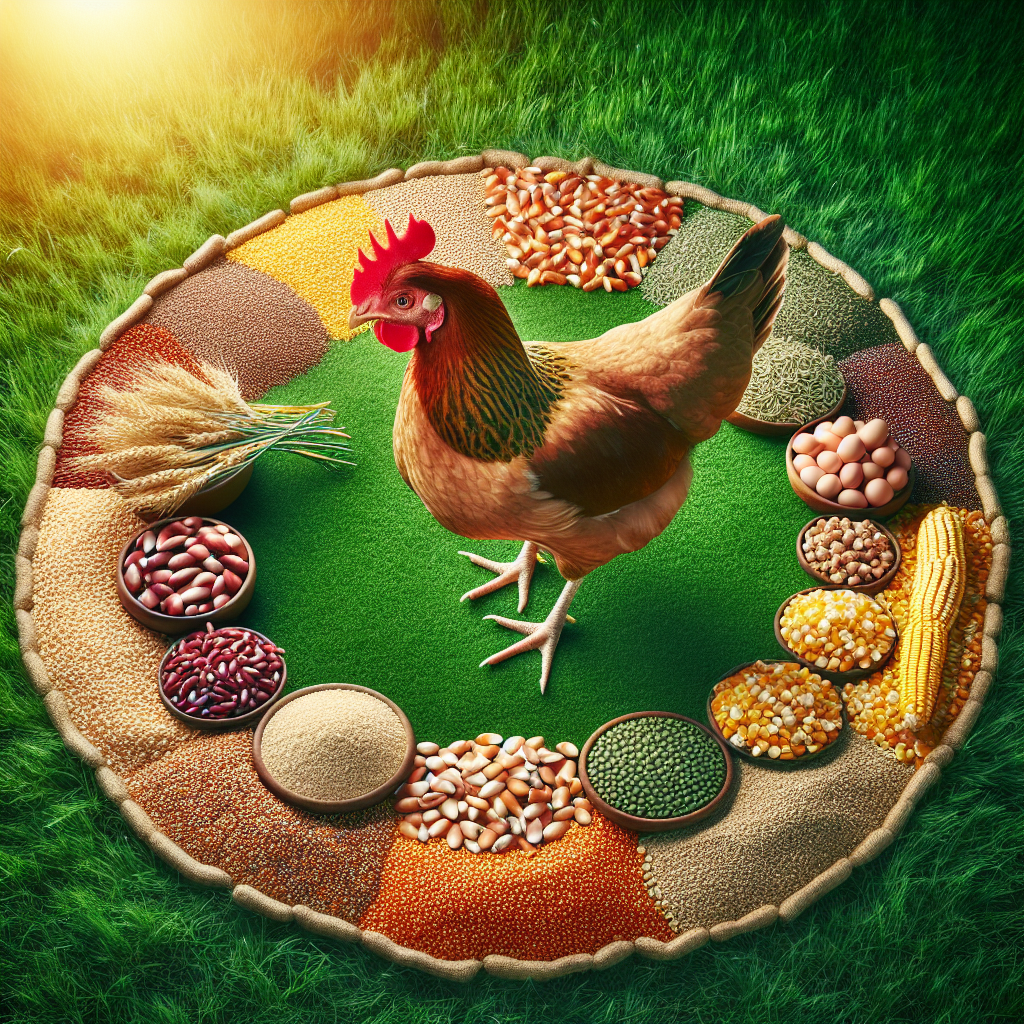Have you ever wondered about the difference in GMO content between organic and non-organic feeds? This article explores this fascinating topic, delving into the variations in GMO content between these two types of feeds. Whether you’re a curious consumer or a farmer looking to make informed choices, understanding the differences in GMO content is essential. So, come along as we unravel the mysteries behind the GMO content in organic and non-organic feeds.
GMO Content in Organic Feeds
Organic Certification Standards
When it comes to organic feeds, one of the primary concerns for consumers is the presence of Genetically Modified Organisms (GMOs). Organic certification standards aim to address these concerns and provide assurance to customers that their feeds are free from GMOs. In order to be certified organic, feeds must meet a set of rigorous criteria established by various organic certification bodies. These criteria include farming practices that prohibit the use of GMO crops and require the use of organic seeds, as well as strict record-keeping and documentation to ensure traceability of the feed ingredients.
GMO Testing and Labeling in Organic Feeds
In order to verify compliance with organic certification standards, organic feeds are subject to GMO testing. This involves analyzing the feed ingredients to detect the presence of GMOs. Testing methods may include PCR (Polymerase Chain Reaction) or ELISA (Enzyme-Linked Immunosorbent Assay), which can accurately detect and quantify GMOs in feed samples. If GMOs are detected in organic feeds, they cannot be labeled as organic and may be subject to penalties or revocation of organic certification.
Common Sources of GMO Contamination in Organic Feeds
While organic certification standards strive to prevent GMO contamination, there is still a risk of unintentional contamination in organic feeds. One of the common sources of GMO contamination is cross-pollination between GMO and non-GMO crops. This can occur when organic farms are located in close proximity to conventional farms that grow GMO crops. Other potential sources of contamination include accidental mixing during storage and transportation, as well as the inadvertent use of GMO-containing inputs, such as manure or compost.
GMO Content in Non-Organic Feeds
Prevalence of GMOs in Non-Organic Feeds
Unlike organic feeds, non-organic or conventional feeds do not have the same strict restrictions on GMOs. As a result, the prevalence of GMOs in non-organic feeds is much higher. The majority of non-organic animal feeds contain genetically modified ingredients, such as soy, corn, and canola. These crops are often genetically modified to be resistant to pests or herbicides, which can increase yields and reduce crop losses.
GMO Testing and Labeling in Non-Organic Feeds
In many countries, there are no mandatory requirements for GMO testing or labeling in non-organic feeds. As a result, consumers often have limited information about the GMO content in the feeds they purchase. Some companies voluntarily conduct GMO testing and provide GMO-free labels for their feeds, but this is not universal. Without proper labeling and testing, it can be challenging for consumers to make informed choices about the GMO content in non-organic feeds.
Common Sources of GMOs in Non-Organic Feeds
The main sources of GMOs in non-organic feeds are genetically modified crops that are used as ingredients. Soy, corn, and canola are particularly common in animal feed formulations. These crops are often grown using genetically modified seeds, which can result in higher yields and better pest resistance. Additionally, non-organic feeds may also contain by-products from genetically modified crops, such as soybean meal or corn gluten meal.
Comparison of GMO Content
Regulatory Differences
One of the key differences between organic and non-organic feeds is the regulatory framework surrounding GMOs. Organic feeds are subject to strict regulations that prohibit the use of GMO crops and require mandatory testing for GMO content. On the other hand, non-organic feeds are typically not subject to the same level of regulations and may not require any GMO testing or labeling. This regulatory disparity means that the GMO content in organic feeds is generally lower and more closely monitored than in non-organic feeds.
GMO Content Variation in Different Types of Organic Feeds
While organic feeds are generally supposed to be GMO-free, there can be variations in GMO content depending on the specific type of organic feed. For example, organic livestock feeds, which are predominantly composed of grains and forages, may have a lower risk of GMO contamination compared to organic feeds that contain common genetically modified ingredients like soy or corn. However, it is important to note that even organic livestock feeds are at risk of GMO contamination due to potential cross-pollination or accidental mixing during processing and transportation.
Factors Influencing GMO Content in Non-Organic Feeds
Several factors contribute to the GMO content in non-organic feeds. The type of feed ingredient is a significant factor, as genetically modified crops like soy and corn are widely used in conventional animal feed formulations. Agricultural practices and regional variations in the cultivation of genetically modified crops also play a role. Additionally, the availability and pricing of non-GMO alternatives can influence the decision to include GMO-containing ingredients in non-organic feeds.
Health Concerns Related to GMO Content
Impact of Consuming GMOs in Animal Feed
Consuming GMOs in animal feed can have potential implications for animal health. While there is no consensus on the long-term effects of GMO consumption in animals, some studies suggest that GMOs may cause adverse effects on animal reproductive and immune systems, as well as organ health. Additionally, certain GMO crops are engineered to produce toxins, which can affect the digestive systems of animals. It is important to note that the effects of GMO consumption may vary depending on the specific crop and genetic modifications involved.
Human Health Risks Associated with Consuming Animals Fed GMOs
The consumption of animals fed GMOs can indirectly affect human health. When animals are fed GMO-containing feeds, the residues of GMOs and associated pesticides may be present in animal products like meat, milk, and eggs. Some studies have raised concerns about potential allergenicity, toxicity, and antibiotic resistance due to these residues. However, more research is needed to fully understand the potential human health risks associated with consuming animal products from animals that were fed GMO-containing feeds.
Ecological Impact of GMOs in Animal Feed
GMOs in animal feeds can also have ecological implications. The cultivation of genetically modified crops often involves the use of herbicides, which can have adverse effects on non-target organisms, including insects, birds, and beneficial insects like bees. Additionally, the use of GMOs in animal feeds can contribute to the ongoing loss of biodiversity, as genetically modified crops may outcompete native varieties and reduce the availability of non-GMO options for animal feed.
GMO-Free Alternatives
Organic Feed Options
For those looking to avoid GMOs in animal feeds, organic feeds provide a reliable solution. Organic feeds are produced using organic farming practices and must adhere to strict GMO-free regulations. By choosing certified organic feeds, you can ensure that your animals are consuming feed that is free from genetically modified ingredients and the associated risks. Organic feeds typically utilize non-GMO crops and organic techniques, providing a natural and sustainable alternative.
Non-Organic GMO-Free Feed Options
In the non-organic sector, there are also GMO-free feed options available. Some feed manufacturers have recognized the demand for GMO-free feeds and have introduced product lines that are labeled as GMO-free. These feeds are produced using non-genetically modified crops and may undergo additional testing or certification to verify their GMO-free status. It is important to check the labeling and certifications provided by the manufacturer to ensure the feed meets your GMO-free requirements.
Impact on Cost and Availability
The availability and cost of GMO-free feed options can vary depending on geographical location and demand. Organic feeds are often more expensive than non-organic feeds due to the higher cost of organic ingredients, as well as the additional requirements for organic farming and certification. GMO-free feeds in the non-organic sector may also be priced higher than conventional feeds because of the extra testing and certifications involved. However, with increasing consumer demand for GMO-free products, the availability and affordability of GMO-free feed options are expected to improve in the future.
In conclusion, the GMO content in organic and non-organic feeds differs significantly. Organic feeds adhere to strict GMO-free certification standards, undergo regular testing, and have tighter regulations compared to non-organic feeds. Non-organic feeds, on the other hand, have a higher prevalence of GMOs and may lack mandatory GMO testing and labeling. The health concerns associated with GMO content in animal feed range from potential negative effects on animal health to indirect impacts on human health and ecological systems. GMO-free alternatives, such as organic feeds and non-organic GMO-free feeds, provide viable options for those seeking to avoid GMOs. While the availability and cost of GMO-free feeds may vary, consumer demand is driving the industry to provide more accessible and affordable options in the future.




